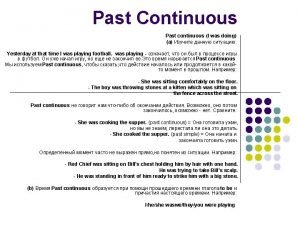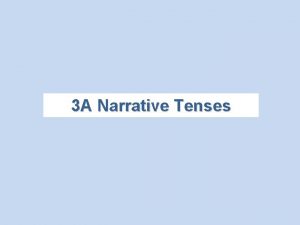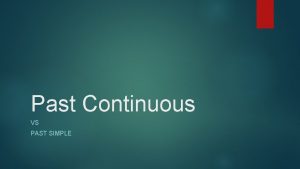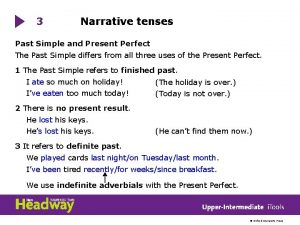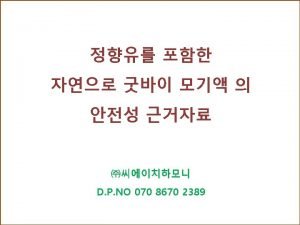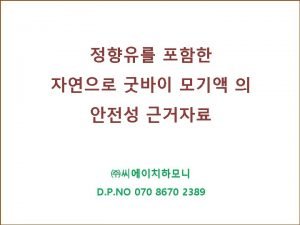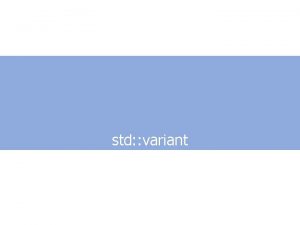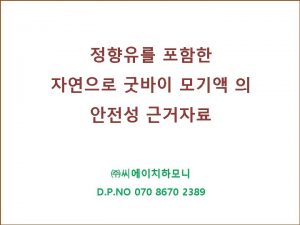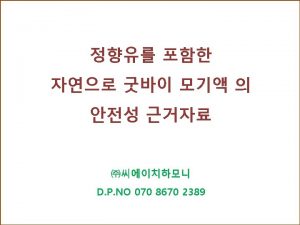Std VI History Studying the Past Studying the








- Slides: 8

Std. VI History Studying the Past

Studying the past KEY WORDS-----History-Systematic description of the past events. Pre History- It refers to that period when the art of writing was unknown. Archaeology- The study of prehistory and history through excavation of sites. Inscriptions- Writing which are engraved on rocks, pillars, clay tablets , caves Epigraphy- The study of inscription is called epigraphy. Monuments- The remains of temples, stupa , Palaces and forts. Manuscripts-Books that were written long ago by hand on palm leaves or barks of trees. Artefact- An object made by a human being. Numismatics-The study of coins.

Time and Date in the History : BC-BEFORE CHRIST, AD- ANNO DOMIMI (in the year of lord) The period before the birth of Christ, you count the years backward. So 500 BC comes after 2500 BC. However in the period after the birth of Christ. AD can be count forward , so AD 500 comes before AD 2500. Nowadays some historians prefer to use the terms BCE and CE in the place of BC and AD. BCE-before common era. CE-Common era. The term circa(or in ca in short)is used when the date of an event is not for sure.

Pre history and History Prehistory | Educational Video for Kids - You. Tube Open the video with -open with hyperlink Q. What is history and why we need to study history ? Ans -History is the study of change over time and progress from the past to the present world. It is based on the fact not on the imagination. It helps us to learn about the great people, culture art and architecture of the earlier times. History motivates us to make the present world a better place to live in. Q. Define prehistory and History. Ans -Prehistory- refers to that period when art of writing was unknown. Our information about prehistory depends upon the remains of tools, bones, pottery and weapons that have been excavated. History- refers to the period after the invention of writing. The written records, dates, names of places and people may be on Bhojapatras, {people write on dried palm leaves} or pillar are the source of information. History is generally categorised into three periods Ancient, Medieval and Modern. Q. The study of history help us to make the present world a better place to live in. How ? Ans- Because it help us to learn about the people, culture , art , architecture of the earlier times.

Distinguish between Archaeological and Literacy Source Secular Literary Sources | Ancient History - 2 | History Optional Open the video -Open hyperlink Archaeological sources—Inscriptions, coin , monuments , skeletons Literary sources- Religious literature , Non-religious literature, Secular literature, Historical literature Q. How does the study of coins help the historians ? Ans-Coins were made of different materials like lead, copper, bronze , iron, gold and even leather. They give information about the art of religion, rulers , the use of different metals and level of development of technology. Q. How does the study of the monuments help the historians ? Ans-The study of monuments helps the historians to know about the social and economic life, the religious beliefs , dress, art forms and architecture of the time. Q. How do skeletal studies help us to identify gender difference ? Ans- The skeleton of a women generally has boarder hip or pelvic area for child bearing. Jeweller found on the skeletons also helps in determining whether the skeleton belongs to a woman or a man. Q. How does the Inscriptions help the historians ? Ans-Writing which are engraved on rocks, pillars, clay tablets, the walls of temples and caves. They tell us about the kings , their empires, achievements As well as the society and the language of that period. The inscriptions of Ashoka’s period tell us about his achievements in the field of administration

Distinguish between Archaeological and Literary source Secular Literary Sources | Ancient History - 2 | History Optional Open The Video with – Open hyperlink Q. What are the Literary sources of Indian history ? Ans -Religious Literature, Non Religious Literature, The Secular Literature , Historical literature. Q. Explain historical literature with example. Ans-Consists of autobiographies of the ancient rulers and biographical sketches like Harashacharita. Q. How do secular literary sources throw light on the life of people in any period of History? Ans- The accounts of events by foreign travellers like Fa-hien {Chinese } and ambassadors like Megasthenes {Greek} who visited India in earlier times , are also important sources of a information about ancient Indian history and culture.

One Mark Questions 1. What is a period refers to when the art of writing was unknown ? Ans – Pre history 2. Who study the objects made and used in the past? Ans –Archaeologist 3. What is the book that were written long ago by hand on the palm leaves Or barks of trees ? Ans – Manuscripts 4. What is called the study of coins ? Ans – Numismatics 5. What is called the study of inscriptions? Ans-Epigraphy 6. Historians divide history into which two parts ? Ans- Pre- history , history 7. Who was the Chinese travellers visited India ? Ans – Fa-hien 8. Which Greek ambassadors visited ? Ans- Megasthenes 9. What is the writing which are engraved on pillars, Clay tablets, The walls of the tamples? Ans – Inscriptions 10. Who the author of Abhigyan Shakuntalam ? Ans- Kalidas

Test your Wisdom 1. History is the study of -(the human body , the environment , the human past) 2. Jain literature was written in which language ? ( Sanskrit, Tamil , Prakrit) 3. Literature consists of prose, plays, poetry etc belongs to-(Religious, Secular, non-religious) 4. The study of Inscriptions is called- (numismatics, history, epigraphy) 5. Before the invention of paper, people wrote on-(notebook, cloth, Bhojpatra) 6. The study of coins is known as-(Architecture, Calligraphy, numismatics) 7. Kautilya write the book- ( Meghdoot, Ramayana, Arthshastra) 8. Who was the Auther of Abhigyan Shakuntalam ? ( Kautilya, Tulsidas, Kalidas) 9. The process of digging under the surface of the earth in order to find old objects( Artifact, History, Excavation) 10. Books that were written long ago by hand on palm leaves or barks of trees( monuments , Epigraphy, monuments) ANSWERS- All 3 rd Options
 Past simple past continuous, past perfect examples
Past simple past continuous, past perfect examples Simple past perfect tense
Simple past perfect tense Past simple past continuous past perfect timeline
Past simple past continuous past perfect timeline Past simple past continuous past perfect
Past simple past continuous past perfect Participle 2 таблица
Participle 2 таблица Narrative tenses past simple
Narrative tenses past simple Past simple past continuous past perfect
Past simple past continuous past perfect Past perfect vs past continuous
Past perfect vs past continuous Simple present for informal narratives
Simple present for informal narratives




